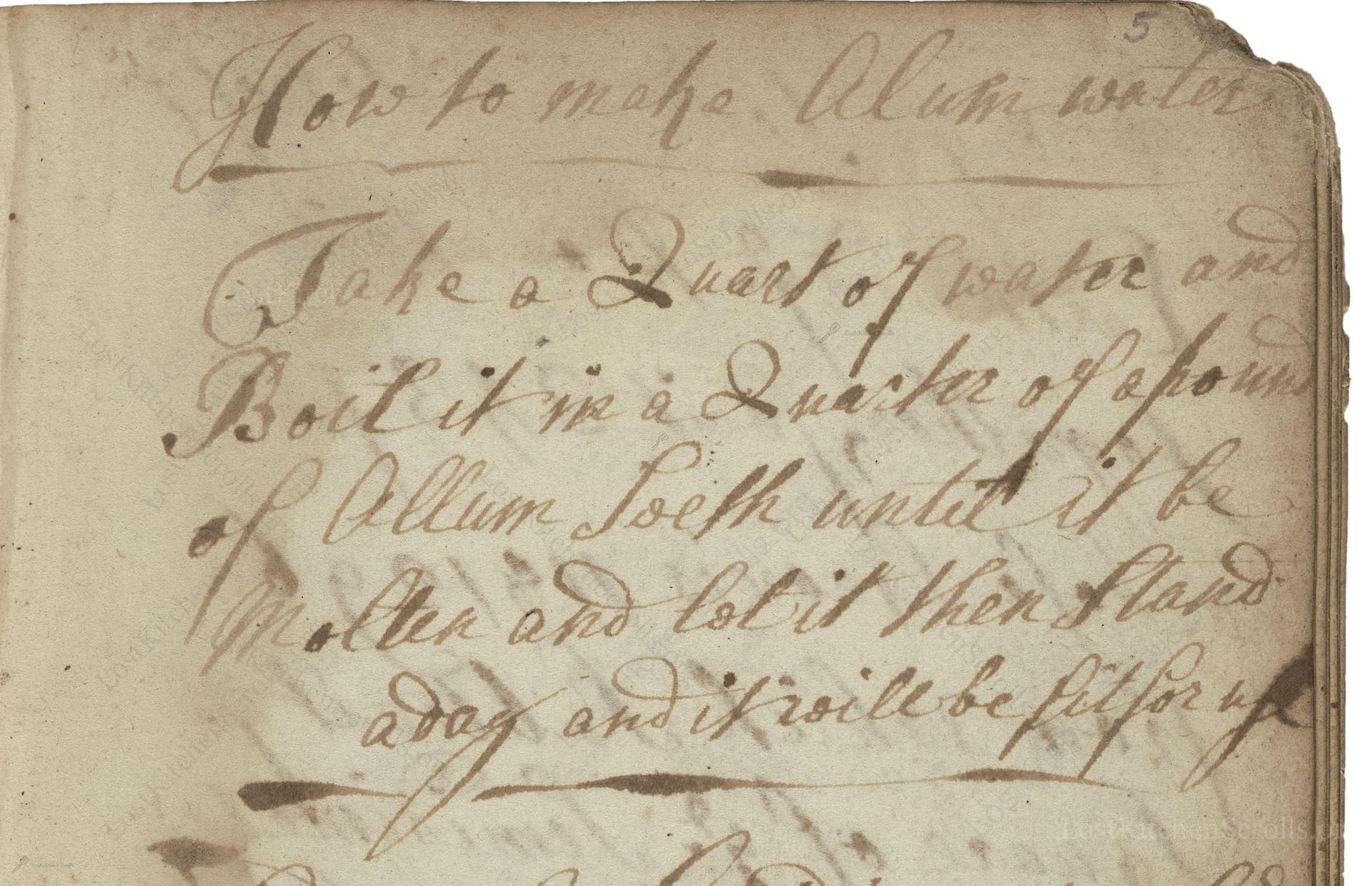How To Make Alum Water
From the treasured pages of Miscellaneous collection of receipts
Unknown Author

How To Make Alum Water
"Take a Quart of water and Boil it in a Quarter of a pound of Allum Soeth untill it be Molten and let it then stand a day and it will be fit for use."
Note on the Original Text
The recipe is written in straightforward, functional Early Modern English, with minimal punctuation and spelling reflecting the norms of the period ('Allum' for alum, 'Soeth' meaning to boil, and 'Molten' meaning melted or dissolved). Instructions are brief, assuming familiarity with common kitchen procedures and measures of the era. Recipes from this time typically leave much implicit, trusting the reader's everyday knowledge.

Title
Miscellaneous collection of receipts (1688)
You can also click the book image above to peruse the original tome
Writer
Unknown
Era
1688
Publisher
Unknown
Background
Step back into the sumptuous kitchens of the late 17th century with this historical culinary treasure, filled with tantalizing recipes and refined techniques perfect for impressing the nobility—or your most discerning dinner guests.
Kindly made available by
Folger Shakespeare Library
This recipe for alum water hails from the late seventeenth century, a time when alum was valued for its astringent and preservative properties. Often used in food preservation, textile dyeing, and even in early medical practices, alum water would have been a common household preparation. The reference comes from a manuscript dated around 1688, placing it firmly in the Restoration period in England, when domestic science and household management manuals were emerging in abundance. Alum water might have been used for pickling, cleaning, or even as a treatment in early cosmetics.

In its original context, this recipe would have been prepared over an open hearth or with early kitchen ranges, using a sturdy iron or earthenware pot. A wooden spoon for stirring and a covered or uncovered container to allow the solution to stand were likely employed. Measuring was approximate, relying on weights such as pounds and quarts, common in early modern English kitchens.
Prep Time
5 mins
Cook Time
10 mins
Servings
1
We've done our best to adapt this historical recipe for modern kitchens, but some details may still need refinement. We warmly welcome feedback from fellow cooks and culinary historians — your insights support the entire community!
Ingredients
- 1 quart water
- 4 ounces alum (potassium aluminum sulfate; food grade if intended for culinary use; if not available, substitute with pickling alum from the spice aisle)
Instructions
- Begin by pouring 1 quart of fresh water into a saucepan.
- Add 4 ounces of alum (potassium aluminum sulfate), and bring the mixture gently to a boil, stirring occasionally.
- Continue simmering until the alum has fully dissolved.
- Once dissolved, remove from heat and allow the solution to stand, uncovered, for 24 hours.
- After this resting period, your alum water is ready for use.
Cooking Estimates
Preparing alum water takes only a few minutes to mix and dissolve the ingredients, but you need to let it rest for 24 hours before it's ready to use. This recipe makes about 1 liter. Since alum is not eaten directly, there are no calories per serving.
As noted above, we have made our best effort to translate and adapt this historical recipe for modern kitchens, taking into account ingredients nowadays, cooking techniques, measurements, and so on. However, historical recipes often contain assumptions that require interpretation.
We'd love for anyone to help improve these adaptations. Community contributions are highly welcome. If you have suggestions, corrections, or cooking tips based on your experience with this recipe, please share them below.
Join the Discussion
Rate This Recipe
Dietary Preference
Main Ingredients
Culinary Technique

Den Bockfisch In Einer Fleisch Suppen Zu Kochen
This recipe hails from a German manuscript cookbook compiled in 1696, a time whe...

Die Grieß Nudlen Zumachen
This recipe comes from a rather mysterious manuscript cookbook, penned anonymous...

Ein Boudain
This recipe comes from an anonymous German-language manuscript cookbook from 169...

Ein Gesaltzen Citroni
This recipe, dating from 1696, comes from an extensive anonymous German cookbook...
Browse our complete collection of time-honored recipes



